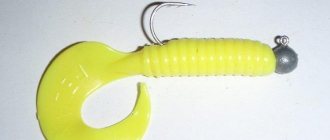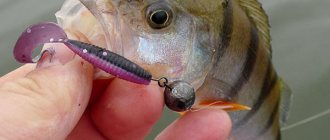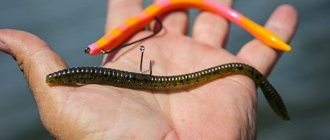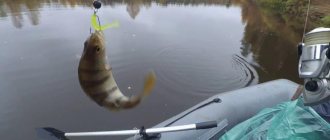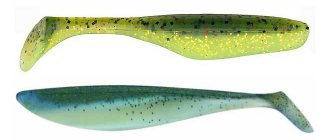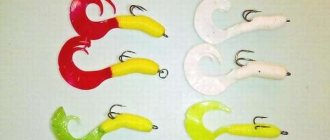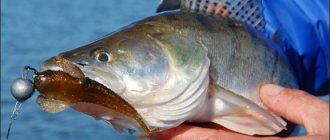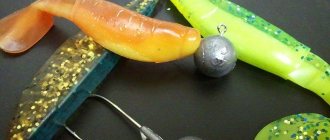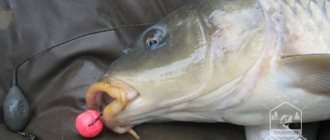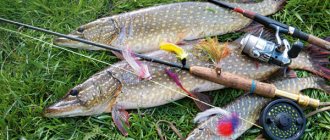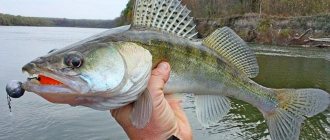Among the various methods of spinning fishing, jig fishing has recently become widespread. One of the key elements of equipment when fishing using this method is a jig head or, as everyone is accustomed to calling it, a G-head. It also works well for winter fishing.
We will talk about what a jig head is, what varieties it comes in, and how to equip a spinning rod and fish with it when using it together with silicone baits in this article.
What is a jig head
A jig head is a lead or tungsten sinker (head) with a double or single hook soldered or hinged to it. To prevent the bait from sliding off the solid heads near the sinker, special clamps in the form of a spike, a ball, a mushroom, or an arrow are cast from the same material as the sinker on the shank of the hook. When using heads with a swivel joint, use hooks with special notches or protrusions on the forend
The main purpose of using this element is to add weight to the bait to increase its casting range, speed up the fall to the bottom, and improve the game with various types of retrieve.
Jig heads differ in weight, shape, and material from which the sinker is made. We will talk about this and much more further.
Jig head casting process
Previously, almost all the boys were engaged in extracting lead from old and unnecessary car or tractor batteries, in order to subsequently cast all kinds of objects from the mined lead, the same brass knuckles, lead bullets for scarecrows and many other things. For those who have experience with such homemade products, the process of casting jig heads is familiar.
To do this, you will need the molds themselves for casting jig heads, which you can also make yourself using plaster, clay, or ordinary earth. But it is unlikely that it will be possible to organize mass production of jig heads in this way; these are most likely one-time experiments. It is best to order high-quality molds for metal casting from friends at the factory or purchase ready-made ones, since today there are plenty of such offers on the World Wide Web, and at very reasonable price parameters.
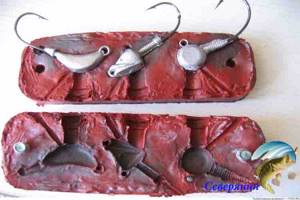
The manufacturing process is very simple; it does not require any special skills or knowledge. Initially, ears, hooks, and swivels should be placed in the molds for pouring. Molten lead or other suitable metal is poured into the finished molds, you should wait until the metal in the mold has completely cooled, remove the workpiece and process it with sandpaper or a file, bite off all excess parts and all jig heads are ready for use.
Which spinning rod to use
For jig fishing, the choice of spinning rod depends on the fishing conditions:
- When fishing on a small lake , stake, pond or small river, it is best to use rods no longer than 210 cm .
- For medium rivers and lakes it is better to use forms 210-240 cm .
- When fishing on large rivers, large lakes , and vast water areas of reservoirs, it is better to use forms longer than 270 cm .
The test form is selected taking into account the total weight of the bait with a jig head and fishing conditions:
- When catching small perch, small pike, in shallow reservoirs with stagnant water, use rods with 2-7 grams of dough.
- For small rivers, streams, ponds and medium-sized lakes with a depth of more than 2 meters, when fishing for pike and perch, use forms with 2-10 grams of dough.
- In conditions of backwaters and river bays, medium-sized reservoirs with standing water and a depth of more than 4 meters, forms with a dough of 5-15-18 grams are used.
- For fishing on rivers with medium or slow currents and depths over 4-5 meters, forms with dough up to 10-30 grams are used.
- When fishing in reservoirs and large rivers with depths of over 6-7 meters, blanks with 15-30 grams of dough are used.
The action of a jig spinning rod should be fast or super fast - only the tip of such a rod should bend under load.
In addition to all the characteristics described above, a jig spinning rod, unlike a twitching rod, should, despite its overall rigidity, have a thin and flexible tip with a large number of small guide rings. This design is necessary in order to use the tip, which is usually painted in a contrasting color relative to the entire blank, to track the moment the bait touches the bottom, and to perform various tosses and pulls.
In addition to the design features and characteristics of the blank, a jig spinning rod should have a comfortable handle - preferably made of cork or soft EVA polymer material - with a reliable reel seat and large guide rings with wear-resistant cermet inserts.
It should be remembered that rods made of fiberglass and low-quality composites are not suitable for jig fishing - such forms are quite heavy and insensitive - the angler’s hand will get tired very quickly and at the same time he will not feel neat and weak bites “in the hand”.
The best option for this method of spinning fishing would be a high-modulus graphite blank with a solid or glued thin tip.
Winterlures
August 2, 2017
Jig heads review. Part one introductory...
Jig head is one of the simplest and most common ways to mount soft spinning baits.
Classification.
Jig head can be classified according to the following parameters:
- Form/Purpose
- Hook
- Material/Weight
- Color
Shape of jig heads - at the moment you can find a wide variety of shapes of jig heads from different manufacturers.
Basic forms:
- Sphere, polyhedron
- Rugby (football, horseshoe, and even Vanka-Vstanka)
- Tablet, eccentric.
- Column (nail)
- Fish head (boot, etc., etc.)
- The ball is a classic, ancient shape. Suitable for many “rubbers”, for different types of equipment.
- Rugby is an interesting form, for slow drive, on small weights. Often available in a non-hinged version.
- Tablet - on small scales it goes well among stones, during jerking maneuvers (twitch), when falling, periodically lie on your side.
- A pole (ski) – the center of gravity is shifted to the center, was invented by the Japanese for sea fishing, and has proven itself well when catching perch with passive rubber.
- Boot (head, etc., etc.) - the shape was most likely invented to diversify the market and assortment for the buyer.
Hook - gone are the days when all jig heads were equipped with Mustad or Canelle, now they can only be found on large Volga jig heads. Or economy class jigs. Now many manufacturers are trying to equip their “work” with Korean or Japanese hooks. This is one of the standards of quality. The width of the bend, the thickness of the wire, the angle of attack of the tip of the sting - everything here depends on the purpose of the jig; for sea fishing, a large bend and thin wire are used, the tip almost sticks up; for freshwater fishing, 0.6 mm thickness is also suitable, but the bend of the forend (eagle claw ) it’s better for us not to be big, there are already enough holds. Owner, Hayabusa, KumhoFreshWater. - These are the main manufacturers of jig hooks today.
The approximate ratio of the size of the hook on the jig head and the rubber (twister, slug or vibrotail) . IMHO, from personal experience. hook
№ 8- most often it fits well on a 1 and 1.5 inch rubber hook
No. 6 - 1.5-2 inches No. 4 - most often used on silicone from 2 to 2.5 inches. No. 2 - here, as you like...from 2 to 3, but most often it is 2.5-2.8 inches.
- The presence or absence of a retainer (spike) on the shank of the hook - at the moment, almost all silicone baits are made of very soft plastic, the spike (retainer) is an evil that will destroy your expensive bait in a matter of minutes. Please note - now almost all jig heads are made on a “bare” forend, sometimes there is a drop of varnish (paint) or winding.
- If necessary, we recommend using wire, spiral, fastener for silicone baits.
Material/Weight – it all depends on your wallet. It is clear that pure chiseled tungsten is heavier and “louder” than its brothers lead and “cast tungsten (powder).” But it will be several times more expensive than them, for example, comparison: 1g. – turned, processed tungsten costs 30-50 rubles. Imagine how much 10 grams will cost. Most often, tungsten is used on pay sites for trout fishing and “sport” fishing...
Personally, I don’t see the difference between “baked” tungsten and lead... Lead is a consumable. Consumables.
Sinker color - fluorescent paints of various colors are now widely and often used, mainly for trout fishing. And catching perch with a micro jig. Everyone has their own taste and color. J
- The shape/weight/hook (hook size), jig heads are selected exclusively for a specific bait or size. There are no laws or axioms here. For example - 2g. head on a large hook for catching pike or large perch in shallow water. And vice versa 4-6g. on a small hook No. 8-6 for fishing on a fast, relatively deep river.
How to equip (plant)
To attach baits equipped with jig heads of various sizes, both metal leashes with fasteners and knotted connections are used. The choice of one or another connection method depends on the conditions and the object of fishing:
- When fishing in shallow ponds and lakes where there is no pike and the main predator is perch, lead rigs are used - “Carolina”, “Texas”, “retractable leash” (Moscow). With this method, the jig head is separated using a leash made of thin and transparent fluorocarbon, so that the sinker in the form of a ball with two ears (Cheburashka) or a sliding “bullet” is located above and attached to the main fishing line, and below it on a piece of fluorocarbon fishing line A silicone bait with a hook is located from 70 to 120 cm long. To make it easier to change baits attached to the leash, a small fastener is attached to its end.
- When fishing for pike, catfish, and pike perch, use a jig head with bait attached to the fastener of a metal leash 15-20 cm long. The leash is tied to the main line or cord using any reliable knot connection.
- When fishing for very large pike and catfish, the nodal connection of the leash with the main fishing line is further strengthened with a drop of “Super Glue”.
Equipment option No. 1
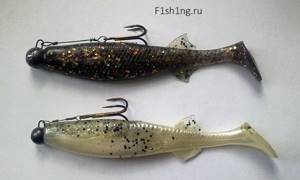
Equipment option No. 2
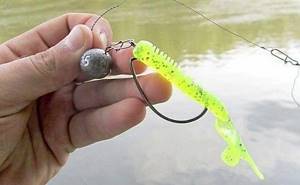
Equipment option No. 3
Floating heads for fishing with silicone baits
In addition to heavy lead jig heads, floating heads are also used when fishing with silicone baits. Larger and loaded options usually work on the surface of water, especially overgrown with algae. Smaller floating heads without loading are effective when working on the bottom using special equipment with a sinker and a lead.
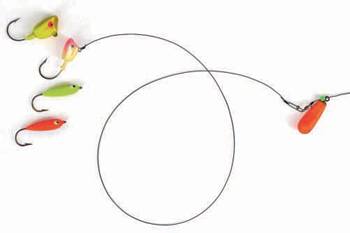
Photo 1. Floating heads on a bottom leader rig.
Who gets caught on a jig?
The following types of predatory fish are caught on jig:
- Pike – catch toothy pike on a jig throughout the open water season. Most successful in mid-spring and autumn.
- Perch – Perch is caught primarily on lead rigs and small silicone jigs, starting in early spring until freeze-up. The most productive way to catch it with this gear is in the fall, when the perch gathers in large groups and hunts collectively.
- Pike-perch – they catch pike-perch on a jig not only in the spring-autumn period, but also in winter on ice-free rivers and in warm canals. This fish is more successfully caught at dusk and at night.
- Catfish - this large river predator is caught using jig gear mainly during the warm season. Like pike perch, it is often caught at night and at dusk.
- Asp - caught on jig gear when fishing for pike on river rifts, near steep rivers, under bushes and tree branches hanging low over the water. Actively caught throughout the summer during daylight hours. Do not feed at night.
Also, such peaceful fish species as:
- Chub - can be caught using small jigs during July-September.
- Ide is actively caught on medium and large rivers using small jig baits. Ide is most active in spring and late summer–early autumn.
Types of jig heads
Depending on the shape of the sinker, the following types of jig heads are distinguished:
Jig heads with hard-soldered hook:
- "Ball";
- "Digger";
- "Swinging";
- "Fish Head"
- "Vatile";
- "The head of the larva";
- "Bullet";
- "Ski";
- "Rugby";
- "Spoon";
- "Slanted";
- "Vanka-Vstanka"
- "Banana";
- "Horse Head";
- "Boot";
- "Horseshoe".
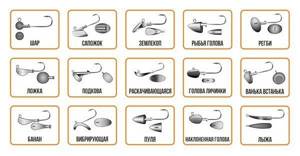
Jig heads with a hinged (movable) connection between the sinker and the hook:
- "Ball";
- "Lentils";
- "Filda."
How to choose a jig head
Choosing a jig head by weight is very important for normal play, long casting and its rapid fall to the bottom.
The weight of the jig head and the size of the hook determine which category of spinning fishing of the same name it is used in:
- The smallest solid and articulated heads with small hooks weighing up to 3 grams are used when fishing with nanojigs. Such heads are used for baits of the smallest sizes when fishing for perch, ide, and chub .
- Heads weighing from 3 to 7 grams are ideal for equipping baits for microjig, the objects of fishing for which are large and medium-sized perch , small grass pike.
- For light jigs, use heads weighing from 10 to 15-20 grams .
- In average jigs, heads weighing from 20 to 30-40 grams . They catch a variety of fish with a medium jig - pike, perch, pike perch .
- When fishing with large baits for heavy jigs, the largest heads with impressive hooks and weighing over 40 grams . This type of jig is used to catch large pike perch, catfish and trophy pike .
The weight of the jig head is also selected taking into account the depths at the fishing site:
- Up to 2 meters – 3-8 grams;
- 2-4 meters – 6-10 grams;
- 4-6 meters – 12-16 grams;
- 6-10 meters – 18-22 grams;
- Over 10 meters – 20-30 grams.
Choosing the right head by weight saves a lot of time and allows you to fish more perceptive places - if you use a head that is too light and takes a long time to submerge, the angler will end up spending significantly more time fishing the place than using a heavier one.
But at the same time, a very heavy head in shallow depths will significantly speed up the fall of the bait and reduce the number of bites that most often occur during the smooth lowering of the bait during the pause between reels or after casting. It is also undesirable to use heavy heads in places with a lot of aquatic vegetation and snags - this will lead to frequent snags and breaks.
Jig fishing video for beginners:
DIY jig heads
Many anglers cast their own jig heads. This is explained not only by the desire to save money, but also by an increase in the range of heads by weight.
The most difficult part is making molds for casting. Some anglers use plaster and matchbox, while others make metal structures.
Before pouring metal molds , it is necessary to lubricate the internal surfaces with animal fat or lard. Then dismantling the mold will be much easier and simpler. Sometimes it is necessary to remove the foundry flash with a knife and file.
Features of jig fishing
Compared to fishing with wobblers, spoons and other baits, jig fishing has a number of the following features:
- Fishing at depth - for fishing with classic jig equipment, a depth of at least 2 meters is required. This is due to the fact that most of the predator’s grip on bait with this fishing method occurs when the bait falls smoothly to the bottom in pauses between reelings and after casting it. If the depth at the fishing spot is shallow, then even the lightest head will not ensure a slow descent of the bait and the predator simply will not notice it.
- Stepped retrieve – for jig fishing, a classic stepped retrieve is used, consisting of 3-4 turns of the reel handle and a pause. The duration of the pause depends on the depth at the fishing site and the weight of the head used. For normal fishing, the pause should last no more than 3-4 seconds. The reeling speed varies depending on the activity of the fish and the season.
- Using special forms - fishing with jig baits requires complete control over the bait. Therefore, only rigid jig rods with a special thin and sensitive tip are suitable for this method, capable of making the longest and most accurate casts, allowing you to make effective sharp and strong hooks, and give the bait a game that attracts predators during various retrieves.
- The use of braided cord - another factor that ensures complete control and high sensitivity of jig spinning tackle is the mandatory use of a hard and thin braided cord. Using fishing line is possible only with a short casting distance and using the smallest baits
- Easy to learn - fishing with jigs, unlike twitching lures, is very easy to learn. It is with this method that many beginners often begin their journey in spinning fishing.
Having learned the basics and subtleties of jig fishing, you can successfully catch a variety of species of both predatory and peaceful fish. Also, another advantage of this fishing method is its low cost and a huge range of silicone baits.
